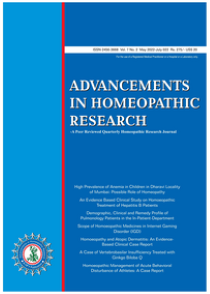Solanum Xanthocarpum: The Unexplored Drug In Managing Urolithiasis- A Case Report
DOI:
https://doi.org/10.48165/ahr.2025.10.2.2Keywords:
Homoeopathy, Urolithiasis, OrganopaAbstract
Urolithiasis, renal stones, kidney stones are used interchangeably to refer to the accretion of hard, solid , non metallic minerals in urinary tract. Different regions of India have varying stone compositions, however there aren't many extensive prospective studies to offer accurate figures.Males are more likely than females to develop urinary stones at all ages. Calcium oxalate is the most common component of urinary stones in Northwestern Rajasthan, regardless of age group. Calculi that are associated with obstruction, renal failure, and infection requires further critical interventions.Treating urolithiasis through organopathic prescription in homoeopathy can beneficial to avoid unwanted complications as in modern line of treatment. Solanum Xanthocarpum, an unexplored drug in field of homoeopathy has shown beneficial results in treating calculi in other systems of medicine. Charak has recommended its use in piles, cough, delirium tremens and calculi expulsion. Shushruta has found its effectiveness in ophthalmia and urinary strictures. Bangasena has recommended its use in cough of children. According to Dr. SC Ghosh Solanum Xanthocarpum is unquestionably a grand medicine in suppression of urine, stricture and calculi explusion and formation. In the cure of these maladies, Solanum Xanthocarpum can be compared with Berberis Vulgaris, Cantharis, Sarsaparilla and lycopodium. This case report enhances the knowledge regarding Solanum Xanthocarpum, its constituents and its beneficial results clinically in treating patient suffering from urolithiasis which is evident through investigations reports of the patient.
References
Lang, J., Narendrula, A., El-Zawahry, A., Sindhwani, P., & Ekwenna, O. (2022). Global trends in incidence and burden of urolithiasis from 1990 to 2019: An analysis of Global Burden of Disease study data. European Urology Open Science, 35, 37–46. https://www.sciencedirect.com/science/article/pii/S2666168321027191
Sohgaura, A., & Bigoniya, P. (2017). A review on epidemiology and etiology of renal stone. American Journal of Drug Discovery and Development, 7, 54–62.
Khan, S., Pearle, M., Robertson, W., Gambaro, G., Canales, B., Doizi, S., et al. (2016). Kidney stones. Nature Reviews Disease Primers, 2, 16008.
Shajari, A., & Sanjerehei, M. M. (2015). Modeling the distribution of urolithiasis prevalence under projected climate change in Iran. Urolithiasis, 43(4), 339–347.
Romero, V., Akpinar, H., & Assimos, D. G. (2010). Kidney stones: A global picture of prevalence, incidence, and associated risk factors. Reviews in Urology, 12(2–3), e86.
Grant, C., Guzman, G., Stainback, R. P., Amdur, R. L., & Mufarrij, P. (2018). Variation in kidney stone composition within the United States. Journal of Endourology, 32(10), 973–977.
Brikowski, T. H., Lotan, Y., & Pearle, M. S. (2008). Climate-related increase in the prevalence of urolithiasis in the United States. Proceedings of the National Academy of Sciences, 105(28), 9841–9846.
Lingeman, J. E., Woods, J., Toth, P. D., Evan, A. P., & McAteer, J. A. (1989). The role of lithotripsy and its side effects. The Journal of Urology, 141(3), 793–797.
Me, A. (2012). Role of homoeopathy in the area of surgery [Internet]. Homeopathy Resource by Homeobook.com. https://www.homeobook.com/role-of-homoeopathy-in-the-area-of-surgery/
Jütte, R., & Riley, D. (2005). A review of the use and role of low potencies in homeopathy. Complementary Therapies in Medicine, 13(4), 291–296.
Gupta, D. Y., & Gaur, P. (n.d.). A review on the therapeutic utility of Solanum xanthocarpum in the field of homoeopathy.
Patel, P. K., Patel, M. A., Vyas, B. A., Shah, D. R., & Gandhi, T. R. (2012). Antiurolithiatic activity of saponin-rich fraction from the fruits of Solanum xanthocarpum Schrad. & Wendl. (Solanaceae) against ethylene glycol induced urolithiasis in rats. Journal of Ethnopharmacology, 144(1), 160–170.
Boericke, W. (2023). New manual of homoeopathic materia medica & repertory with relationship of remedies: Including Indian drugs, nosodes, uncommon, rare remedies, mother tinctures, relationship, sides of the body, drug affinities & list of abbreviations (3rd ed.). B. Jain Publishers.
Ghose, S. C. (1984). Drugs of Hindoosthan: With their homoeopathic uses, provings and clinical verifications (9th ed.). Calcutta.




